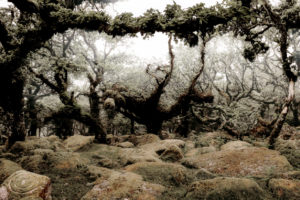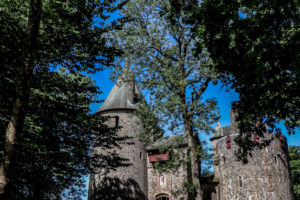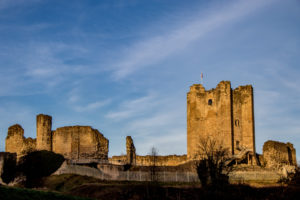 Framlingham Castle is a castle in the market town of Framlingham in Suffolk in England. An early motte and bailey or ringwork Norman castle was built on the Framlingham site by 1148, but this was destroyed (slighted) by Henry II of England in the aftermath of the revolt of 1173–4. Its replacement, constructed by Roger Bigod, the Earl of Norfolk, was unusual for the time in having no central keep, but instead using a curtain wall with thirteen mural towers to defend the center of the castle. Despite this, the castle was successfully taken by King John in 1216 after a short siege.
Framlingham Castle is a castle in the market town of Framlingham in Suffolk in England. An early motte and bailey or ringwork Norman castle was built on the Framlingham site by 1148, but this was destroyed (slighted) by Henry II of England in the aftermath of the revolt of 1173–4. Its replacement, constructed by Roger Bigod, the Earl of Norfolk, was unusual for the time in having no central keep, but instead using a curtain wall with thirteen mural towers to defend the center of the castle. Despite this, the castle was successfully taken by King John in 1216 after a short siege.
The population of Framlingham in Suffolk rose sharply after the Norman invasion of England as the village turned into a small town of at least 600 inhabitants, surrounded by valuable lands in one of the most prosperous parts of the country. The region was owned by the powerful Hugh d’Avranches, the Earl of Chester, who granted it in turn to Roger Bigod, the Sheriff of Suffolk. A ringwork or motte and bailey castle was first built in either the 11th or early 12th century in the northern half of the Inner Court of the current castle.
Although the first documentary reference to a castle at Framlingham occurs in 1148, the actual date of its construction is uncertain and three possible options have been suggested by academics. The first possibility is that the castle was built by Roger Bigod in either the late 11th century or around 1100, similar to the founding of Bigod’s caput at nearby Eye. A second possibility is that Roger’s son, Hugh Bigod, built it during the years of the Anarchy in the 1140s on the site of an existing manor house; the castle would then be similar to the Bigod fortification at Bungay. A third possibility is that there were in fact two castles: the first being built in the late 11th century and then demolished by Hugh Bigod in the 1160s in order to make way for a newer, larger castle. Historian Magnus Alexander hypothesizes the castle might have been built on top of a set of pre-existing Anglo-Saxon, high prestige buildings, a practice common elsewhere in East Anglia, possibly echoing the arrangement at Castle Acre; this would be most likely if the castle was built in the 11th century.
By the late 12th century the Bigod family had come to dominate Suffolk, holding the title of the Earl of Norfolk and owning Framlingham and three other major castles at Bungay, Walton, and Thetford. The first set of stone buildings, including the first hall, were built within the castle during the 1160s. Tensions persisted throughout the period, however, between the Crown and the Bigods. Hugh Bigod was one of a group of dissenting barons during the Anarchy in the reign of King Stephen, and after coming to power Henry II attempted to re-establish royal influence across the region. As part of this effort, Henry confiscated the four Bigod castles from Hugh in 1157 but returned both Framlingham and Bungay in 1165.
Hugh then joined the revolt by Henry’s sons in 1173. The attempt to overthrow Henry was unsuccessful, and in punishment the king ordered several Bigod castles, including Framlingham, to be destroyed. The king’s engineer, Alnoth, destroyed the fortifications and filled in the moat at Framlingham between 1174–6, although he probably shored up, rather than destroyed, the internal stone buildings.
Hugh’s son, Roger Bigod, was out of favor with Henry, who initially denied him the family earldom and estates such as Framlingham. Roger finally regained royal favor when Richard I succeeded to the throne in 1189. Roger then set about building a new castle on the Framlingham site – the work was conducted relatively quickly and the castle was certainly complete by 1213. The new castle comprised the Inner Court, defended with 13 mural towers; an adjacent Lower Court with smaller stone walls and towers, and a larger Bailey with timber defenses. By this time, a castle-guard system was in place at Framlingham, in which lands were granted to local lords in return for their providing knights or soldiers to guard the castle.







